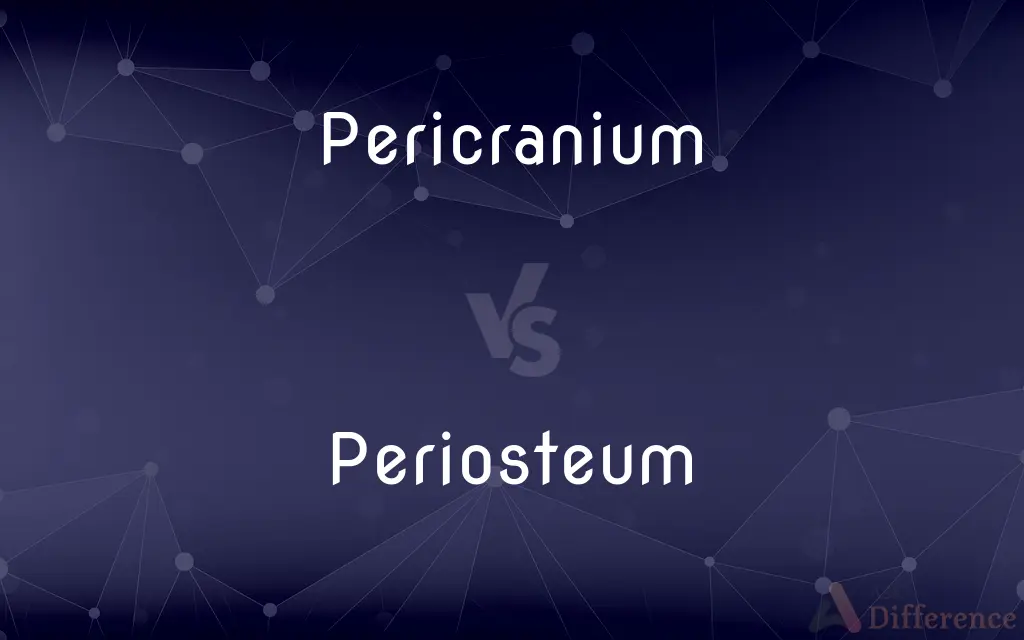Pericranium vs. Periosteum — What's the Difference?
Edited by Tayyaba Rehman — By Maham Liaqat — Updated on March 27, 2024
Pericranium is the membrane covering the outer surface of the skull, while periosteum covers bones' outer surfaces, providing nourishment and aiding in repair.

Difference Between Pericranium and Periosteum
Table of Contents
ADVERTISEMENT
Key Differences
The pericranium is a dense layer of connective tissue that serves as the outermost covering of the skull bones, playing a crucial role in providing nutrients to the skull and facilitating its repair and growth. On the other hand, the periosteum is a similar membrane that envelops the outer surface of all bones, not just the skull, ensuring their nourishment, growth, and repair.
While the pericranium is specific to the skull, acting as a protective layer and aiding in the attachment of muscles and ligaments, the periosteum covers bones throughout the body, containing cells that are essential for bone growth and healing. This distinction underlines the specialized nature of the pericranium in relation to the skull's unique requirements.
Both the pericranium and periosteum are involved in the process of bone healing and regeneration, but the periosteum, given its presence on all bones, plays a broader role in the skeletal system's overall health and maintenance. The periosteum's osteogenic layer is particularly vital for bone regeneration and repair.
In surgical procedures or injuries involving the skull, the pericranium may be carefully preserved or used in reconstructive efforts due to its regenerative properties. Conversely, the periosteum's preservation is crucial in surgeries on other bones to ensure proper healing and bone integrity.
The pericranium and periosteum also differ in their response to disease and injury. The periosteum's rich blood supply and nerve endings make it highly sensitive to changes, contributing to pain sensation in bone injuries. The pericranium, while also sensitive, is specifically tuned to the needs and protection of the skull bones.
ADVERTISEMENT
Comparison Chart
Location
Outer surface of the skull
Outer surface of all bones except skull
Function
Nutrient supply, growth, and repair of skull
Nutrient supply, growth, and repair of bones
Composition
Dense layer of connective tissue
Dense layer of connective tissue with an osteogenic layer
Role in Healing
Facilitates skull bone healing
Facilitates bone healing throughout the body
Sensitivity
Sensitive to changes, less involved in pain sensation
Highly sensitive, involved in pain sensation of bone injuries
Compare with Definitions
Pericranium
Often preserved or repaired during cranial surgery to aid in skull healing.
The pericranium was repositioned by the neurosurgeon to ensure proper healing post-surgery.
Periosteum
Envelops the bones of the body, excluding the skull.
The periosteum is carefully preserved during orthopedic surgeries to facilitate bone healing.
Pericranium
Provides nutrients and support for the skull's growth and repair.
The pericranium played a vital role in the healing process after the patient suffered a skull fracture.
Periosteum
A membrane that covers the outer surface of all bones, providing nourishment and aiding in repair.
The periosteum contains cells essential for bone regeneration, making it crucial for healing fractures.
Pericranium
While sensitive, its primary concern is the protection and nutrition of the skull.
The pericranium's integrity is crucial for the skull's overall health and recovery from injury.
Periosteum
Serves as a source of bone cells for growth and healing; contains nerve fibers.
Damage to the periosteum can significantly affect the bone's ability to heal and regenerate.
Pericranium
Covers the outer surface of the skull bones exclusively.
Injuries to the head can damage the pericranium, affecting the skull's ability to repair.
Periosteum
Highly sensitive to changes, playing a role in the pain associated with bone injuries.
Inflammation of the periosteum can cause severe pain due to its nerve supply.
Pericranium
The outermost layer of connective tissue covering the skull.
The surgeon carefully separated the pericranium from the skull to access the bone.
Periosteum
Essential for the regeneration and repair of bones throughout the body.
The osteogenic layer of the periosteum was activated to repair the bone fracture.
Pericranium
The periosteum (vascular connective tissue) enveloping the skull.
Periosteum
The periosteum is a membrane that covers the outer surface of all bones, except at the articular surfaces (i.e. the parts within a joint space) of long bones.
Pericranium
The external periosteum that covers the outer surface of the skull.
Periosteum
A dense layer of vascular connective tissue enveloping the bones except at the surfaces of the joints.
Pericranium
(anatomy) The membrane (or periosteum) which covers the outer surface of the skull.
Periosteum
The dense fibrous membrane covering the surface of bones except at the joints and serving as an attachment for muscles and tendons.
Pericranium
The head, skull; one's mind.
Periosteum
A membrane surrounding a bone.
Pericranium
The periosteum which covers the cranium externally; the region around the cranium.
Periosteum
The membrane of fibrous connective tissue which closely invests all bones except at the articular surfaces.
Common Curiosities
How do pericranium and periosteum contribute to bone health?
They supply nutrients, support bone growth, and facilitate healing and repair.
Is the periosteum present in all bones?
The periosteum covers all bones except for areas of joint cartilage; the pericranium is specific to the skull.
Why is the pericranium important in cranial surgeries?
Its preservation is crucial for skull healing and regeneration post-surgery.
Can the pericranium and periosteum regenerate bone?
Yes, both have roles in bone regeneration, with the periosteum playing a broader role across all bones.
How do pericranium and periosteum differ in their sensitivity to injury?
While both are sensitive, the periosteum's rich blood supply and nerve endings make it more involved in pain sensation.
Can the pericranium be used in reconstructive efforts?
Yes, its regenerative properties may be utilized in cranial reconstructive surgeries to promote healing.
What makes the periosteum sensitive to pain?
Its rich nerve supply makes it highly sensitive, contributing to pain sensation in bone injuries.
What is the main difference between pericranium and periosteum?
The pericranium covers the skull's outer surface, while the periosteum covers all other bones, aiding in their growth and repair.
How does the pericranium affect the skull's ability to repair after injury?
Its integrity is vital for the skull's healing, supplying necessary nutrients and supporting bone regeneration.
Can damage to the periosteum affect bone growth?
Yes, since the periosteum contains cells vital for bone growth and repair, damage can impair these processes.
What role does the pericranium play in the body?
It provides protection, nutrients, and support specifically for the skull's growth and repair.
Why is the periosteum considered crucial for orthopedic surgeries?
Its role in bone healing and regeneration makes its preservation important during surgeries to ensure proper bone repair.
How are pericranium and periosteum similar?
Both are connective tissue layers that cover bones, supporting their nourishment and repair, but differ in location and specific functions.
What happens if the periosteum is damaged?
Bone healing and growth can be compromised, potentially leading to more complex medical issues.
What is the osteogenic layer in the periosteum?
It's a layer rich in precursor cells that contribute to bone growth and healing.
Share Your Discovery

Previous Comparison
Idealism vs. Pragmatism
Next Comparison
Consequent vs. SubsequentAuthor Spotlight
Written by
Maham LiaqatEdited by
Tayyaba RehmanTayyaba Rehman is a distinguished writer, currently serving as a primary contributor to askdifference.com. As a researcher in semantics and etymology, Tayyaba's passion for the complexity of languages and their distinctions has found a perfect home on the platform. Tayyaba delves into the intricacies of language, distinguishing between commonly confused words and phrases, thereby providing clarity for readers worldwide.














































